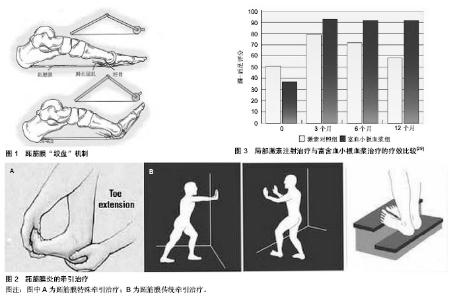| [1] Stiell WF. Painful heel. Practitioner. 1922;108: 345.
[2] Lapidus PW,Guidotti FP.Painful heel: report of 323 patients with 364 painful heels. Clin Orthop.1965;39: 178-186.
[3] Hicks JH. The mechanics of the foot: the plantar aponeurosis and the arch. J Anat. 1954; 88: 25-30.
[4] Glazer JL. An approach to the diagnosis and treatment of plantar fasciitis. Phys Sportsmed.2009;37:74-79.
[5] Gill LH.Plantar fasciitis:diagnosis and conservative treatment.J Am Acad Orthop Surg.1997;5:109-117.
[6] Martin RL, Irrgang JJ, Conti SF. Outcome study of subjects with insertional plantar fasciitis. Foot Ankle Int. 1998;19: 803-811.
[7] Tomas JL,Christensen JC,Kravitz SR,et al.Te diagnosis and treatment of heal pain:a clinical practice.guideline revision 2010.J Foot Ankle Surg. 2010;49(suppl):S1-S19.
[8] Arangio GA, Chen C, Kim W. Effect of cutting the plantar fascia on mechanical properties of the foot.Clin Orthop. 1997; 339: 227-231.
[9] Kim W, Voloshin AS. Role of the plantar fascia in the load bearing capacity of the human foot.J Biomech.1995;28: 1025-1033.
[10] Wearing SC,Smeathers JE,Yates B,et al.Sagittal movement of the medial longitudinal arch is unchanged in plantar fasciitis. Med Sci Sports Exerc.2004; 36:1761-7
[11] Donley BG,Moore T,Sferra J,et al.Te efcacy of oral nonsteroidal antiinfammatory medication(NSAID)in the treatment of plantar fasciitis: a randomized, prospective, placebo-controlled study. Foot Ankle Int.2007;28:20-23.
[12] DiGiovanni B,Nawoczensk D,Lintal M,et al.Tissuespecific plantar fascia-stretching exercise enhances outcomes in patients with chronic heel pain: A prospective, randomized study.J Bone Joint Surg Am.2003;85:1270-1277.
[13] DiGiovanni BF, Nawoczenski DA,Malay DP,et al. Plantar fascia specifc stretching exercise improves outcomes in patients with chronic plantar fasciitis: a prospective clinic trial with two-year follow up.J Bone Joint Surg Am. 2006; 88:1775-1781.
[14] Pfefer G,Bacchetti P,Deland J,et al.Comparison of custom and prefabricated orthoses in the initial treatment of proximal plantar fasciitis. Foot Ankle Int. 1999;20:214-221.
[15] Lee SY, McKeon P,Hertel J.Does the use of orthoses improve selfreported pain and function measures in patients with plantar fasciitis? A meta-analysis. Phys Ter Sport. 2009;10: 12-18.
[16] Hawke F, Burns J,Radford JA,et al. Custom-made foot orthoses for the treatment of foot pain. Cochrane Database Syst Rev. 2008;(3):CD006801.
[17] Fong DT, Pang KY, Chung MM, et al. Evaluation of combined prescription of rocker sole shoes and custommade foot orthoses for the treatment of plantar fasciitis. Clin Biomech. 2012;27:1072-1077.
[18] Kayano J. Dynamic function of medial foot arch. Nippon Seikeigeka Gakkai Zasshi. 1986; 60: 1147-56
[19] Wang CJ. Extracorporeal shockwave therapy in musculoskeletal disorders. J Orthop Surg Res. 2012;7:11.
[20] 陶泉.体外冲击波治疗临床应用进展[J].中华物理医学与康复杂志,2011,33(5):396-398.
[21] Othman AM,Ragab EM.Endoscopic plantar fasciotomy versus extracorporeal shock wave therapy for treatment of chronic plantar fasciitis Arch Orthop Trauma Surg.2010;130: 1343-1347.
[22] 郑悦承.软组织贴扎技术[M].台北:合记图书出版社,2007.
[23] van de Water AT,Speksnijder CM.Efficacy of taping for the treatment of plantar fasciosis:a systematic review of controlled trials.JAm Podiatr Med Assoc.2010;100:41-51
[24] Landorf KB,Menz HB.Plantar heel pain and fasciitis.Clin Evid (Online).2008;2008:1111.
[25] Ball EM, McKeeman HM, Patterson C,et al.Steroid injection for inferior heel pain: a randomized controlled trial. Ann Rheum Dis. 2013;72:996-1002.
[26] Uden H, Boesch E, Kumar S.Plantar fasciitis–to jab or support? A systematic review of the current best evidence. J Multidiscip Healthc.2011;4:155-164.
[27] Mishra A, Woodall J Jr,Vieira A.Treatment of tendon and muscle using platelet rich plasma. Clin Sports Med.2009;28: 113-125.
[28] Shetty VD.Platelet rich plasma: a ‘feeling’ and ‘hope’ ailing athletes. Br J Sports Med. 2010;44(suppl 1):i1-i82.
[29] Ragab EM,Othman AM.Platelets rich plasma for treatment of chronic plantar fasciitis. Arch Orthop Trauma Surg. 2012;132: 1065-1070.
[30] Neufeld SK, Cerrato R.Plantar fasciitis: evaluation and treatment. J Am Acad Orthop Surg. 2008;16:338-346.
[31] Saxena A. Uniportal endoscopic plantar fasciotomy: a prospective study on athletic patients. Foot Ankle Int. 2004;25: 882-889.
[32] Lemont H,Ammirati K,Usen N.Plantar fasciitis:a degenerative process (fasciosis) without inflammation. JAPMA.2003;93: 234-237.
[33] Huang CK, Kitaoka HB, An KN, et al. Biomechanical stability of the arch. Foot Ankle 1993; 14: 353-357.
[34] Sorensen MD, Hyer CF, Philbin TM.Percutaneous bipolar radiofrequency microdebridement for recalcitrant proximal plantar fasciosis. J Foot Ankle Surg.2011;50:165-170. |

